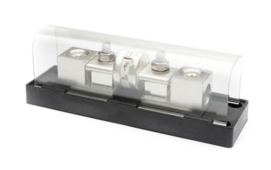A long while ago I bought my 250A Class T fuses and holders from shunts.com. Good price and actually had them in stock at the time too.
But... I goofed.

Bare wire termination. Somehow, I don't think that I should be sticking my fine strand welding wire in there and cranking the screw down, right?
Meaning, I need to either use a ferrule (which 2/0 ferrules and crimpers are expensive), or buy new fuse holders with lug terminations, right?
Just double checking before I go blow another $100 on a pair of fuse holders
But... I goofed.

Bare wire termination. Somehow, I don't think that I should be sticking my fine strand welding wire in there and cranking the screw down, right?
Meaning, I need to either use a ferrule (which 2/0 ferrules and crimpers are expensive), or buy new fuse holders with lug terminations, right?
Just double checking before I go blow another $100 on a pair of fuse holders







